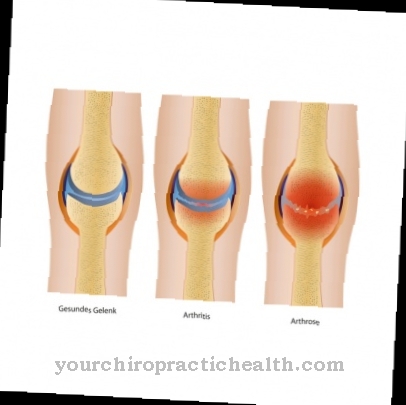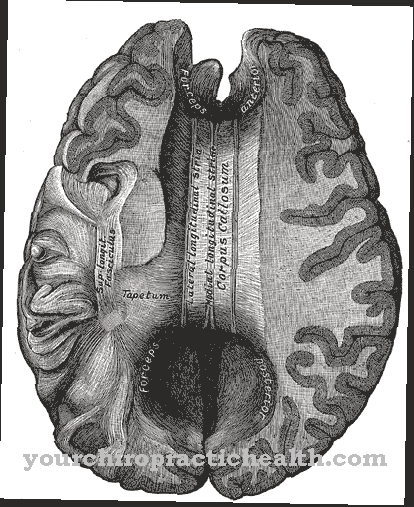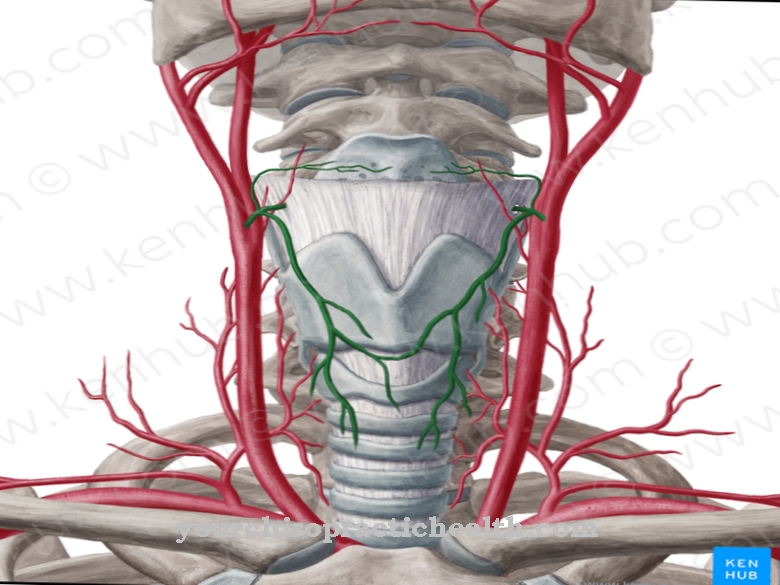Intervertebral joints connect vertebrae together. Depending on their location, they give the spine different degrees of mobility and at the same time stabilize the vertebrae. Facet syndrome is a painful disorder of the intervertebral joints that is related to osteoarthritis.
What is the intervertebral joint?
Joints create a flexible connection between two or more bones. The human body has more than 140 joints. Depending on their location and the functional requirements placed on them, the bone connections are one of several types of joint.
As an intervertebral joint, Facet joint or Vertebral joint the paired joint connection between articular processes of adjacent vertebrae is called. Vertebral arch joint and small vertebral joint are considered synonymous terms. Like any joint, the vertebral joint creates mobility. In the case of the intervertebral joint, it is about the mobility of the spine. The articulation joints are sometimes also referred to as articulations. Unlike other types of joints, the sliding joint does not have a key-in-lock anatomy.
The connections are therefore not constructed according to the form-in-counter-form principle and accordingly do not interlock, but consist of relatively smooth joint surfaces. These joint surfaces form a functional unit with the intervertebral discs and the ligaments, which allows slight sliding movements.
Anatomy & structure
Intervertebral joints are flat joints with flat joint surfaces and a relatively wide joint capsule, which are classified as diarthroses. The cartilage surfaces of the superior articular processes of each vertebra meet in the intervertebral joint with the inferior articular processes of the higher vertebra.
The respective position of the joint surfaces involved differs in the individual sections of the spine, which results in a different degree of mobility of the intervertebral joints. The vertebral joints are each located on the processes of neighboring vertebrae in the lumbar and cervical spine. In the cervical spine, the joint surfaces are approximately in the transverse plane when they are in the zero position, with the superior articular processes of the joint pointing in the dorsal-cranial direction.
Within the thoracic spine, the articular surfaces of the vertebral joints are also in the dorsal-cranial direction, with an additional lateral incline. The lumbar spine in turn supports the joint surfaces in the sagittal plane. In addition to the intervertebral discs and ligaments, meniscoid synovial folds also contribute to the functional entirety of the intervertebral joint. They protrude like a sickle into the joint space and are made up of vascular, loose or tight connective tissue that comes from the joint capsule and is encased by an intima.
Function & tasks
Intervertebral joints articulately connect the vertebrae of the lumbar, thoracic and cervical spine and thus give the structures a certain degree of movement. Without the vertebral joints, for example, a person would not be able to bend down or turn to one side. In the cervical spine in particular, mobility is required through the vertebral arch joints, as otherwise the head could not be rotated.
From an evolutionary perspective, turning the head is not insignificantly involved in survival. People perceive noises that make them aware of dangers and, relatively automatically, direct their eyes in the direction of the noise. This gives you a complete picture of situations in the shortest possible time. Without the vertebral joints, fixation and the rapid change of fixation points would always be tied to the current field of vision. In their entirety, the intervertebral joints give the different sections of the spine three degrees of freedom, which are ideally geared to the functional requirements of the individual spine sections. Flexion and extension are possible, for example, in the sagittal plane, so that the spine can be bent back and forth.
The lateral flexion corresponds to a lateral inclination that is possible in the frontal plane. The spine is also only able to rotate through its intervertebral joints. In the area of the cervical spine, the special anatomy of the joints enables a pronounced rotational movement, which makes the cervical spine the most flexible section of the spine due to the requirements described above. The rotation possibilities in the lumbar spine are less than in the cervical spine due to the lower demands.
The meniscoid synovial folds compensate for the incongruence of the articulating joint surfaces when they move. In addition to mobility, intervertebral joints also guarantee stability and ensure that the spine does not twist.
Diseases
In addition to the herniated disc, the so-called facet syndrome is one of the best-known functional impairments of the intervertebral joints. In a healthy back, vertebrae, joints, ligaments and intervertebral discs cooperate ideally with one another.
The back receives elasticity, stability and functional resilience. In old age, however, the spine often shows signs of wear and tear. A lack of exercise, obesity and genetic disposition are risk factors for increased wear and tear or even osteoarthritis of the facet joints, which can already occur in the mid-30s. The intervertebral discs lose water content with age, lose height and stiffen. The lower elasticity of these structures affects the vertebrae, which slowly lose their distance from one another. If the ligaments also wear out, the spine loses its stability.
As a result, the facet joints are exposed to increasing loads that can cause effusions and inflammatory reactions. The facet syndrome basically corresponds to a load-related arthrosis of the intervertebral joints, which is associated with severe back and neck pain. Since the facet joints have an extraordinarily large number of nerves, the result is primarily deeply radiating back pain that increases with the load.
In the morning, patients usually feel stiff, especially in the lumbar spine, and suffer from pain throughout the day that gets worse when they lean back. In addition to muscle tension, facet syndrome can also cause diffuse pain in the buttocks or legs. Depending on the back segments damaged by the inflammatory reactions, numbness or other abnormal sensations and even motor deficits may occur over time.












.jpg)



.jpg)










.jpg)
